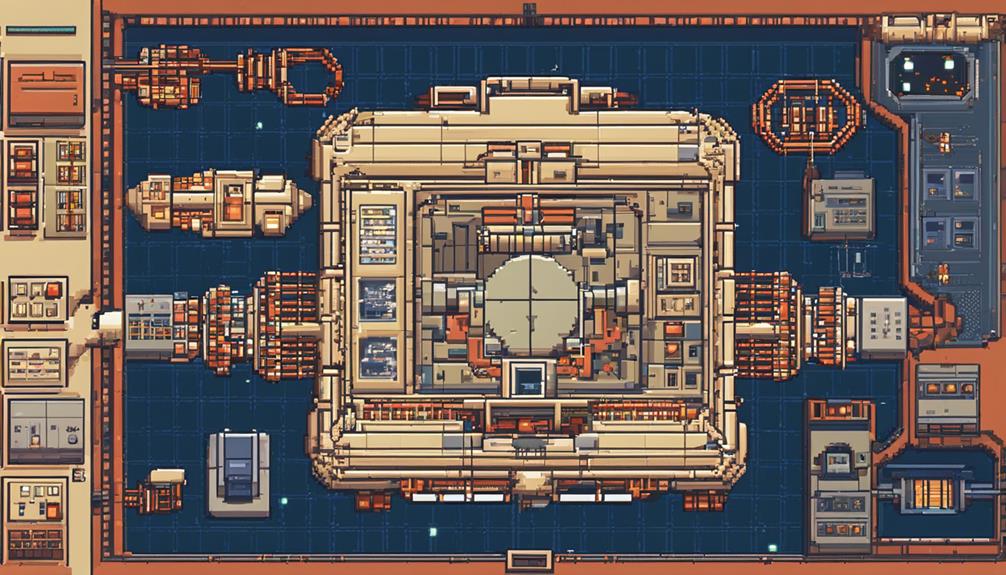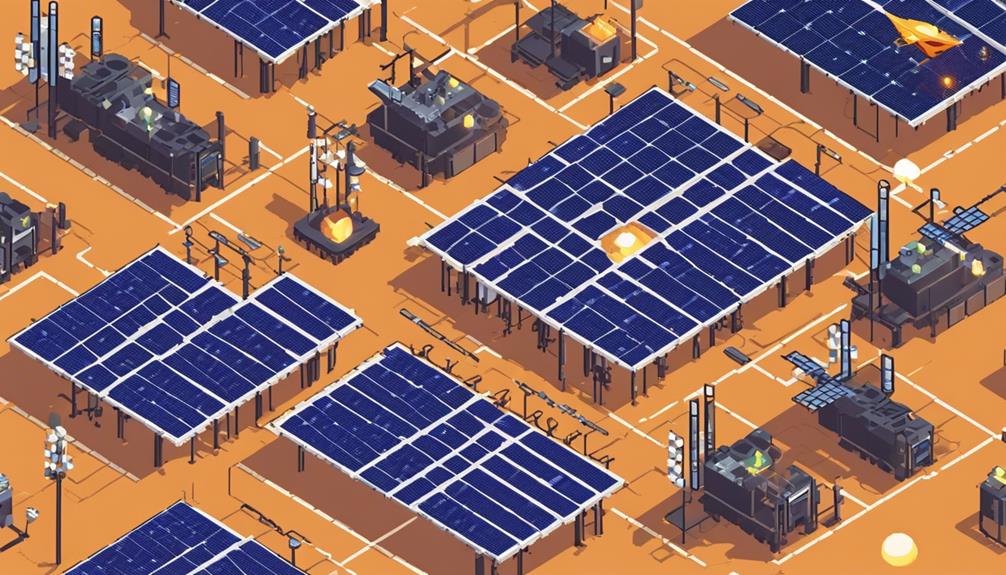Satellites, the sophisticated marvels orbiting our planet, are meticulously crafted with a complex interplay of structural components. From the frame design that provides the backbone to the propulsion systems that ensure precise positioning, each element serves a critical function. But what truly sets these components apart is not just their individual contributions but the seamless integration that enables satellites to thrive in the harsh environment of space. Let's explore how these structural components come together to form the backbone of satellite technology and propel us into the future of space exploration.
Key Takeaways
- Lightweight materials like aluminum and composites ensure structural integrity and stability in satellite frames.
- Thermal control systems using materials like titanium regulate temperatures for operational efficiency in space.
- Communication systems, including antennas and propulsion mechanisms, are essential for connectivity and positioning in orbit.
- Redundancy features like backup power systems and fail-safes prevent catastrophic failures, ensuring mission success and longevity.
Frame Design

Satellite frames, constructed from lightweight materials such as aluminum or carbon fiber, play a crucial role in providing structural integrity and support for satellite components during launch and space operations. The frame design is a critical aspect that ensures the overall strength and stability of the satellite structure. By utilizing lightweight materials like aluminum or carbon fiber, the frames help reduce the overall weight of the satellite without compromising on strength.
In the realm of frame design, structural support is paramount. Engineers meticulously engineer the frames to withstand the rigorous stresses experienced during launch and while in orbit. These frames are not just structural elements but are carefully crafted to provide a stable foundation for mounting various satellite components. Integrating mounting points within the frame design allows for the secure attachment of different modules, instruments, and payloads.
Furthermore, the frame design is not merely functional but also strategic. Engineers often optimize the shape and configuration of the frame to maximize space utilization within the satellite structure. This thoughtful design approach ensures that the satellite components are securely housed within the frame while maintaining structural integrity and minimizing weight. Ultimately, the frame design is a cornerstone of satellite construction, combining strength, lightweight materials, and strategic mounting points to support the satellite's functionality in the demanding environment of space.
Body Structure
The body structure of a satellite is a critical element responsible for supporting various satellite components. It is designed to provide a robust framework for mounting essential equipment such as solar panels, antennas, and payload elements. The body structure must be carefully engineered to withstand the extreme conditions of launch and space while ensuring the structural integrity of the satellite throughout its operational lifespan.
Material Selection for Body
Material selection for the body structure of satellites is a critical consideration due to the demanding requirements of space environments. When choosing materials, factors such as the ability to withstand thermal variations, radiation exposure, and mechanical stresses during launch need to be carefully assessed. Commonly used materials like aluminum, titanium, and advanced composite materials offer a good balance between strength, weight, and durability. Composite materials, in particular, have gained popularity due to their high strength-to-weight ratio and resistance to temperature extremes. Lightweight materials are preferred to reduce overall satellite weight, which is crucial for optimizing launch costs. Ensuring that the body structure can support other components such as solar panels while enduring the harsh conditions of space is paramount in satellite design.
Strength and Durability
In the realm of satellite engineering, the structural integrity and resilience of the body components play a pivotal role in ensuring mission success and operational longevity. Satellite structural components are meticulously designed to endure the harsh conditions of space, such as microgravity and extreme temperatures. Typically constructed from lightweight yet robust materials like aluminum or carbon fiber composites, these components form the foundation for securely mounting other satellite systems and payload instruments. The strength and durability of satellite structures are paramount for guaranteeing overall functionality and longevity in orbit. Engineers employ sophisticated modeling and testing techniques to fine-tune the structural design of satellites, aiming to achieve maximum strength and reliability while navigating the rigors of the space environment.
Design for Functionality
With a focus on ensuring the structural integrity and functionality of satellites, the design for functionality of the body structure encompasses the critical aspects of providing robust support for all satellite components. The structural components, including the frame, support structures, and panels, play a vital role in safeguarding the satellite's internal systems and overall integrity. These components are meticulously designed to withstand the unforgiving conditions of space, ensuring the satellite's durability throughout its mission. Engineers meticulously select materials and construct these components to guarantee the satellite's stability and longevity. The table below highlights the key structural components involved in the design for functionality of satellite body structure.
| Structural Component | Description | Function |
|---|---|---|
| Frame | Provides structural support | Ensures overall stability |
| Panels | Protects internal systems | Safeguards satellite |
| Support Structures | Reinforces critical areas | Enhances structural integrity |
Thermal Control Systems
Thermal control systems in satellites play a pivotal role in regulating temperatures to ensure operational efficiency. Material selection for radiators and insulating layers is critical in managing heat dissipation and maintaining stable internal temperatures. By effectively dissipating excess heat and insulating against extreme external conditions, these systems safeguard satellite components from thermal stress, contributing to overall mission success.
Material Selection
Material selection plays a critical role in ensuring the effective management of temperature extremes within satellite thermal control systems.
- High thermal conductivity and low outgassing properties are essential for satellite thermal control materials.
- Commonly used materials like aluminum and titanium offer suitable thermal properties.
- Various metal alloys are also utilized for their thermal conductivity and durability.
Selecting the appropriate material is crucial to maintain the thermal balance of the satellite components. Coatings are often applied to enhance thermal properties and safeguard against temperature fluctuations. Factors such as thermal conductivity, weight, durability, and compatibility with other satellite components drive the selection process, ensuring optimal performance in the challenging conditions of space.
Heat Dissipation
Efficient heat dissipation is a critical aspect of satellite thermal control systems, essential for managing the thermal loads generated by electronic components. Radiators play a vital role in these systems by dissipating excess heat into space. Insulation materials are used to regulate internal temperatures and shield the satellite from extreme thermal conditions. Thermal blankets and coatings help in managing heat distribution and preventing overheating. Proper thermal management is imperative for ensuring the durability and optimal functioning of satellite components.
| Components | Functionality |
|---|---|
| Radiators | Release heat into space |
| Insulation Materials | Regulate internal temperatures |
| Thermal Blankets | Manage heat distribution |
Solar Panels

Solar panels on satellites serve as crucial components responsible for converting sunlight into electrical power necessary for satellite operations in space. These solar panels are typically composed of silicon cells that have the capability to generate electricity when exposed to sunlight. The efficiency of these solar panels is paramount as it directly impacts the amount of power that can be generated in orbit. Moreover, the amount of sunlight exposure and the orientation of the solar panels play a vital role in determining their overall performance on satellites.
- Solar panels harness solar energy to provide the primary source of power for satellite functions.
- The efficiency of solar panels is essential for maximizing power generation capabilities in the harsh space environment.
- Proper orientation and exposure to sunlight are critical factors that influence the effectiveness of solar panels on satellites.
Antennas and Communication Systems
Satellites rely on antennas and communication systems to establish vital connections with Earth and other spacecraft, enabling the transmission of data, images, and commands essential for their operations in space. Satellite antennas play a critical role in facilitating communication by transmitting and receiving signals. These antennas come in various types, including parabolic, helical, and phased array antennas. Parabolic antennas are commonly used for their high gain and directivity, making them suitable for long-distance communication. Helical antennas are known for their circular polarization and are often used in satellite communication systems. Phased array antennas provide electronic beam steering, allowing for rapid and precise signal tracking.
Communication systems on satellites consist of antennas, transponders, and receivers. These systems enable satellites to receive signals from Earth stations, process the information through transponders, and retransmit the signals back to different locations on Earth. Satellite communication systems operate using different frequencies for data transmission and reception, allowing for efficient and reliable communication. The seamless integration of antennas and communication systems is essential for ensuring uninterrupted data transfer, image dissemination, and command execution between satellites, Earth stations, and other spacecraft in orbit.
Propulsion Systems

Propulsion systems play a pivotal role in satellite operations, facilitating orbit adjustments and precise positioning in space. The following key points shed light on the significance of propulsion systems in satellite functionality:
- Thrusters: Satellites rely on rockets or thrusters in their propulsion systems to generate the necessary thrust for orbital maneuvers. These thrusters are essential for adjusting the satellite's trajectory and maintaining its position in space.
- Fuel Type: The type of fuel used in a satellite's propulsion system directly impacts its efficiency and operational capabilities. Choosing the right fuel is crucial as it affects the satellite's lifespan and its ability to perform required maneuvers effectively.
- Attitude Control: Thrusters within the propulsion system not only assist in orbit adjustments but also play a vital role in attitude control. By firing these thrusters in specific directions, satellites can maintain the correct orientation for their intended tasks, ensuring optimal functionality.
Attitude Control Mechanisms
An integral aspect of satellite operations involves the implementation of precise attitude control mechanisms to maintain the spacecraft's orientation in the space environment. Attitude control mechanisms are essential for pointing antennas, solar panels, and cameras accurately, ensuring effective communication and power generation for the satellite. Two primary components commonly used for attitude control are reaction wheels and thrusters. Reaction wheels operate on the principle of conservation of angular momentum, enabling the satellite to adjust its orientation without the need for fuel. These wheels spin in the opposite direction to the desired turn, causing the satellite to rotate in the intended direction.
Gyroscopes play a crucial role in the attitude control system by measuring the satellite's orientation and detecting any deviations from the desired position. They provide information to the control system, allowing for precise adjustments to be made to maintain the satellite's correct alignment. By continuously monitoring and adjusting the satellite's orientation using reaction wheels, thrusters, and gyroscopes, the attitude control mechanisms ensure that the satellite functions optimally in orbit, fulfilling its intended tasks efficiently.
Redundancy and Fail-Safes

Redundancy and fail-safes play a critical role in ensuring the operational reliability and longevity of satellite systems in the demanding environment of space.
- Redundancy in satellite structural components involves backup systems or elements to ensure continued functionality in case of primary component failure.
- Fail-safes in satellite structures are mechanisms or protocols designed to prevent catastrophic failures and maintain operational integrity.
- Redundant structural components may include duplicate power systems, communication antennas, or propulsion mechanisms.
In satellite systems, redundancy is implemented to provide backup solutions for critical components. Duplicate power systems, communication antennas, or propulsion mechanisms are examples of redundant components that ensure the satellite's functionality even if one system fails. On the other hand, fail-safes are crucial mechanisms that prevent catastrophic failures. These fail-safe designs often include automatic shutdown protocols or emergency procedures that activate in case of a critical issue. By incorporating redundancy and fail-safes, satellite systems can mitigate risks and ensure mission success in the harsh environment of space. These backup systems and automatic shutdown protocols are essential for maintaining operational integrity and safeguarding the satellite's functionality throughout its mission lifespan.
Frequently Asked Questions
What Are the Components of a Satellite?
When considering the components of a satellite, key elements include orbital mechanics, solar panels for power generation, payload integration for equipment deployment, communication antennas for data transmission, attitude control for orientation, and propulsion systems for maneuvering. Additionally, thermal regulation systems are vital for temperature control in space. These components collectively contribute to the functionality and operation of a satellite in orbit.
What Is the Structure of Satellite?
In the realm of satellite engineering, the structure plays a pivotal role in ensuring the mission's success. From addressing weight distribution to managing thermal control and radiation shielding, the satellite's structural design is meticulously crafted. Launch considerations and orbit adjustments are factored into the design, alongside the integration of communication antennas and solar panels. The structure serves as the foundation for the satellite's functionality and resilience in the harsh environment of space.
What Elements Are Used in Satellites?
Satellites utilize various elements for their diverse functions: Satellite propulsion enables orbital adjustments and maneuvering, satellite communication involves antennas and transponders for data transmission, satellite power systems consist of solar panels and batteries for energy generation and storage, and satellite thermal control employs radiators and heat pipes to regulate temperature. These components are essential for the proper functioning of satellites in space missions, ensuring operational efficiency and longevity.
What Materials Are Used in Satellite Structure?
Aluminum alloys are a popular choice in satellite structures due to their optimal balance of strength and weight. Carbon fiber, known for its exceptional durability, reinforces these structures. Titanium panels provide strength and corrosion resistance. Kevlar reinforcements enhance the robustness of critical components. Stainless steel and ceramic coatings offer additional protection. Composite materials, often in honeycomb structures, are utilized to ensure the satellite structure can withstand the demanding conditions of space.
